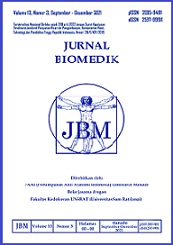THERAPEUTIC OPTIONS FOR THE TREATMENT OF CHRONIC LYMPHOCYTIC LEUKEMIA
DOI:
https://doi.org/10.35790/jbm.1.3.2009.830Abstract
Abstrak: Leukemia limfositik kronis (LLK) merupakan penyakit limfoproliferatif kronis yang ditandai oleh adanya akumulasi dan proliferasi sel B-matur, dengan fungsi kekebalan yang tidak kompeten, di dalam sumsum tulang, darah, kelenjar getah bening, limpa dan hati. Lebih dari 50% pasien tidak menunjukkan gejala pada saat terdiagnosis, dan biasanya tidak memerlukan pengobatan. Pada LKK yang lanjut dan progresif perlu diberikan pengobatan. Klorambusil dengan atau tanpa steroid telah merupakan obat pilihan selama bertahun-tahun pada pasien yang sebelumnya tidak pernah diobati sebagai LLK. Analog nukleosida purin, misalnya fludarabin, kladribin dan pentostatin juga telah diperkenalkan untuk pengobatan LLK. Namun, kemoterapi ini berisiko karena dapat menimbulkan konsekuensi problematis, seperti mielosupresi dan imunosupresi, yang dapat berakibat terjadinya infeksi oportunistik dan keganasan sekunder. Dewasa ini, penggunaan beberapa agen baru pada pengobatan LKK telah menunjukkan perkem-bangan yang menjanjikan, di antaranya adalah antibodi monoklonal. Selain itu transplantasi sel hemapoetik autologus dan alogenik semakin perlu dipertimbangkan pada pengobatan LKK, khususnya bagi mereka yang tidak dapat mentolerir terapi standar dengan dosis tinggi atau LLK yang berisiko tinggi. Penulisan ini difokuskan terutama pada strategi terapeutik LKK, termasuk mekanisme aksi obat serta respon terhadap pengobatan.
Kata kunci: leukemia limfositik kronik, kemoterapi, antibodi monoklonal, HSCT.
Â
Â
Abstract: Chronic lymphocytic leukemia (CLL) is a chronic B-lineage lymphoproliferative disorder, characterized by accumulation and proliferation of B-mature cells, which are immunologically incompetent, in bone marrow, blood, lymph nodes, spleen, and liver. More than 50% of patients are asymptomatic at the time of diagnosis, and they usually require no treatment. However, treatment is needed in the advanced and progressive stages of CLL. Chlorambucil with or without steroids has been the drug of choice for many years in previously untreated CLL patients. The purine nucleoside analogues, e.g. fludarabine, cladribine, and pentostatin, have also been introduced for the treatment of CLL. However, this chemotherapy is risky, because it can cause problematic consequences such as myelosupression and immuno-supression, that can lead to opportunistic infections and secondary malignancies. Recently, several new agents appear promising in treating CLL, including new monoclonal antibodies. Moreover, using autologous and allogenic hematopoietic cell transplantations is increasingly being considered for the treatment of patients with CLL, especially for those who do not tolerate the high dose of standard therapies or suffer from high risk CLL. This paper focuses mainly on the therapeutic strategies in CLL, including the actions of the agents as well as the responses to the treatments.
Keywords: Chronic lymphocytic leukemia, chemotherapy, monoclonal antibodies, HSCT.
Downloads
Issue
Section
License
Penyunting menerima sumbangan tulisan yang BELUM PERNAH diterbitkan dalam media lain. Naskah yang masuk dievaluasi dan disunting keseragaman format istilah dan cara penulisan sesuai dengan format penulisan yang terlampir dalam jurnal ini.
Segala isi dan permasalahan mengenai tulisan yang yang diterbitkan dalam jurnal menjadi tanggung jawab penuh dari penulis.







